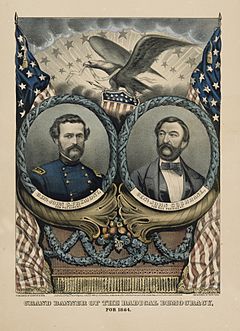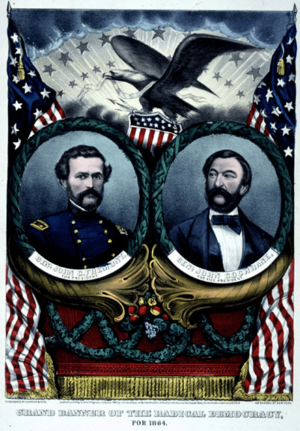Radical Democracy Party (United States) facts for kids
Quick facts for kids
Radical Democracy Party
|
|
|---|---|
 |
|
| Founded | May 1864 |
| Dissolved | September 1864 |
| Split from | Republican Party War Democrats |
| Preceded by | Radical faction of the Republican Party |
| Merged into | National Union Party |
| Succeeded by | Radical faction of the Republican Party |
| Newspaper | New Nation |
| Ideology | Abolitionism Unconditional Unionism Hardline Reconstructionism Radicalism Pro-civil liberties Pro-political reform |
| Political position | Big tent |
The Radical Democracy Party was a political party in the United States. It was formed in 1864 during the American Civil War. This party strongly opposed slavery and the Confederacy.
Many members were Radical Republicans who felt that President Abraham Lincoln was not doing enough. They thought Lincoln was too mild on ending slavery and ensuring racial equality. The party chose John C. Frémont as their candidate for president. John Cochrane was his running mate. However, their campaign did not gain much support. They did not want to take votes away from Lincoln, so they quit the race in September 1864.
Contents
The Party's Beginnings
Cleveland Convention: A New Political Voice
The Radical Democracy Party held its first meeting in Cleveland, Ohio, in May 1864. This was just one week before the Republican convention. Different people reported different numbers of attendees, from 200 to 2,000. The numbers often depended on who was giving the estimate.
Besides Radical Republicans, some Democrats also attended. These Democrats were unhappy that their own party seemed less committed to fighting the Confederacy.
Key Leaders and Supporters
The famous abolitionist John C. Frémont was chosen as the presidential candidate. He had also run for president before as a Republican. John Cochrane, a War Democrat, was nominated for vice president.
Many important figures supported or attended the convention. These included:
- Frederick Douglass, a leading abolitionist and writer.
- Elizabeth Cady Stanton, a pioneer for women's rights.
- Parker Pillsbury, another strong abolitionist.
Abolitionist Wendell Phillips could not attend in person. However, he sent a letter that was read aloud. In his letter, he criticized Lincoln's plan for reconstruction after the war. He said Lincoln's plan would make freedom for Black people "a sham." He believed it would keep slavery alive in a different way.
What the Party Stood For
The party's platform, or main ideas, was decided in Cleveland. It called for:
- Continuing the war against the Confederacy without giving up.
- A Constitutional amendment to ban slavery and grant equal rights.
- Taking property from rebels.
- Letting Congress control how the country was rebuilt after the war.
- Enforcing the Monroe Doctrine, which aimed to prevent European interference in the Americas.
The platform also suggested that a president should only serve one term. It also called for other government reforms. To attract Democrats, the party emphasized protecting important rights. These included freedom of speech, a free press, and habeas corpus. Democrats had criticized Lincoln for limiting these rights during the war.
Historian James M. McPherson noted a compromise. To appeal to Democrats, the party did not specifically call for Black people to have the right to vote. They also did not call for land grants for formerly enslaved people. These were things they might have supported otherwise.
The 1864 Campaign
Many who supported the new party did not actually want it to run in the election. Instead, they hoped its formation would stop Lincoln from getting the Republican nomination. This did not happen. Frémont stated he would drop out if Lincoln also withdrew. He wanted a candidate whose ideas were closer to the Radical Republicans' goals.
Why Support Was Limited
Frémont did get support from some important abolitionists. However, most Radical Republicans still backed Lincoln. They felt Frémont could not win. They worried that supporting him would split the anti-slavery vote. This split could help the Democratic candidate, George B. McClellan, win.
Also, many were not excited about the party's platform. They disliked the compromises made to attract Democrats. Frémont continued to try and win over Democrats during his campaign. As his campaign lost steam, many abolitionists urged him to withdraw. No major newspaper supported Frémont. However, some newspapers that supported Democrats, like the New York World, praised Frémont. They hoped to divide the Republican vote. Both Confederates and Democrats watched Frémont's campaign closely. They hoped it would help McClellan win in November.
Withdrawal from the Race
Frémont and Cochrane left the presidential race on September 21, 1864. Frémont wrote a letter to The New York Times. In it, he said it was clear that Democrats could not be trusted on keeping the Union together or ending slavery. Because of this, he did not want to take votes away from Lincoln.
However, Frémont still criticized Lincoln. He wrote that Lincoln's government had failed in politics, military, and money. He said it was a "cause of regret for the country" that Lincoln's leadership had to continue. In another letter published in the same newspaper, he wrote that the Radical Democracy Party's ideas would still be pursued. Some people think Frémont's withdrawal was part of a deal with Lincoln. This deal might have involved Lincoln removing Montgomery Blair, a more conservative Postmaster General, from his job.
Most Radical Democracy Party supporters then backed Lincoln in the general election. A few, like Wendell Phillips, did not. The party itself ended. It had formed only to run a candidate in the 1864 election.
See also
- Liberty Party (United States, 1840) – an earlier small abolitionist party that this party was compared to


